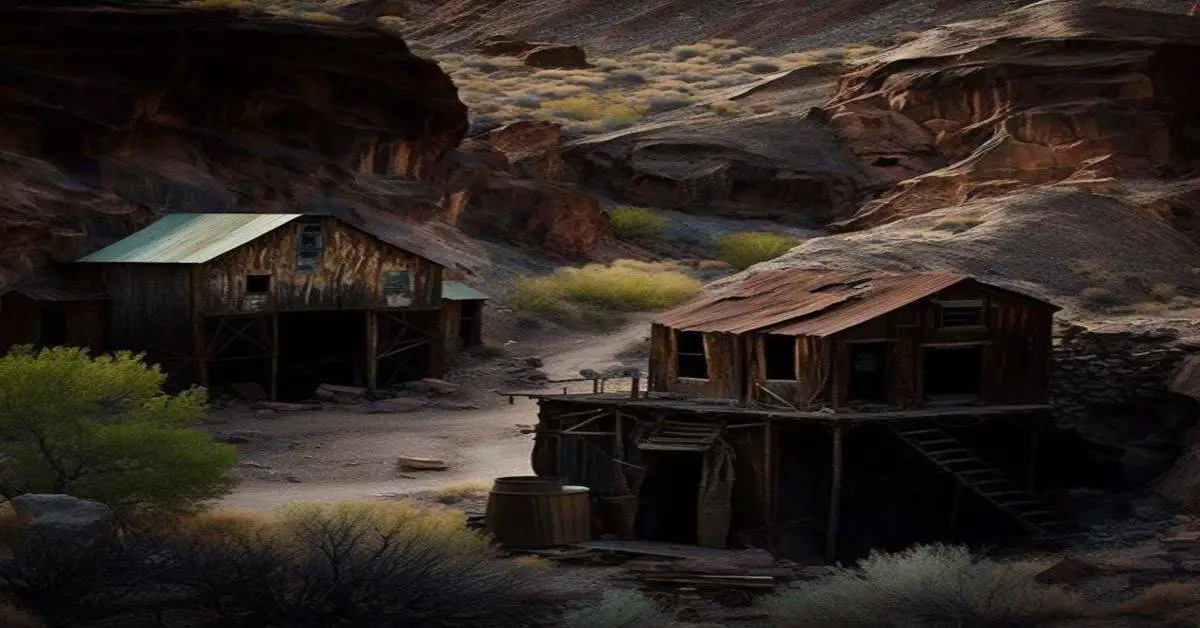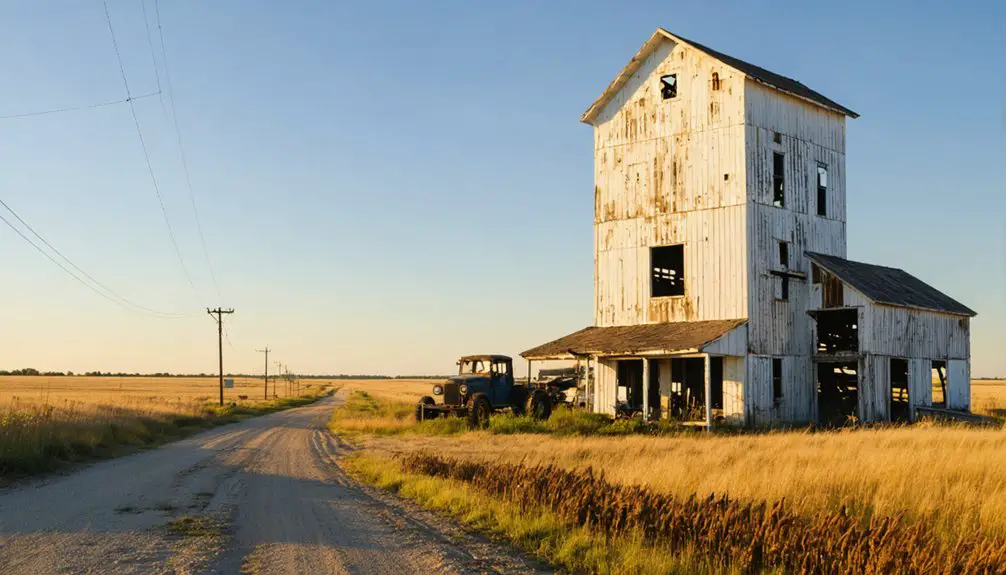You’ll find Lincoln Valley, a ghost town established by German-Russian immigrants in 1900, nestled 8 miles northeast of McClusky in central North Dakota. Founded by George and Conrad C. Reiswig, the community thrived around its general store and post office until the 1970s. Without a vital railroad connection, the town gradually declined as younger generations left for opportunities elsewhere. Today, only faint traces of foundations and cultural heritage remain, waiting to reveal their stories.
Key Takeaways
- Lincoln Valley, founded around 1900 by German/Russian immigrants, is now a ghost town located 8 miles northeast of McClusky, North Dakota.
- The town’s decline began when it missed vital railroad connections, leading to economic challenges and eventual business closures.
- The post office’s closure in the early 1970s marked a significant turning point, as younger generations left for opportunities elsewhere.
- Only faint traces of building foundations and road patterns remain, with the site requiring GPS or detailed maps for navigation.
- The town’s German-Russian heritage is preserved through documentation efforts, including records of architecture, customs, and cemetery iron crosses.
Origins and Early Settlement
Around 1900, German/Russian immigrants George and Conrad C. Reiswig ventured to establish a new settlement in North Dakota, bringing their vision of agricultural freedom to the American frontier.
You’ll find that these founding families, including Abraham Reiswig, carefully selected this location to create a farming community that would preserve their cultural heritage while embracing new opportunities.
Initially named Lincoln before becoming Lincoln Valley, the settlement attracted other German/Russian immigrants who shared similar dreams of independence through land ownership.
These pioneers implemented agricultural practices from their European roots, focusing on acquiring and cultivating the land. Like many railroad towns of the era, the community’s growth was closely tied to transportation development.
The town’s early development included a general store operated by Adam and Freda Goetz that served as a vital hub for the community’s commerce.
While they sold parcels to the Great Northern Railroad and incoming settlers, you’ll discover their primary goal remained steadfast: building a self-reliant farming community where their traditions could flourish.
The Promise of Railroad Dreams
While the Northern Pacific Railroad began its ambitious expansion across North Dakota in 1870, reaching the Missouri River by 1873, Lincoln Valley’s future hinged on the promise of a different rail line.
The prospect of railroad expansion drove community development across the state, transforming countless prairie settlements into bustling towns. The railroad received 60 million acres in land grants to build transportation infrastructure across the region. Conrad and Abraham Reiswig founded Lincoln Valley around 1900, selling land to Great Northern Railroad for a potential line extension.
Here’s what you’d have witnessed during this era of railroad dreams:
- Towns strategically positioned themselves along potential rail routes, hoping to become essential transportation hubs.
- Railroad companies wielded enormous influence, determining which communities would thrive.
- Local settlers invested their futures based on promised rail connections.
- Communities like Lincoln Valley staked their existence on railroad plans that never materialized.
The stark reality of missed rail connections meant some towns, including Lincoln Valley, would fade into obscurity while others flourished along established routes.
German-Russian Heritage
If you’d explored Lincoln Valley in its early days, you’d have found a tight-knit German-Russian community that preserved its Black Sea region customs through traditional gabled-roof architecture, Russian-influenced farming techniques, and ethnic social gatherings.
The settlement pattern followed typical German-Russian preferences, with family farms clustered near enough for community support while maintaining agricultural independence. Like many settlers who formed the German-Russian triangle, these immigrants established themselves in the Dakota Territory, seeking opportunities for farming and cultural preservation. Founded by George and Conrad Reiswig in 1900, the town represented the pioneering spirit of German-Russian immigrants.
Though Lincoln Valley stands empty today, the surrounding region’s German-Russian heritage lives on through preserved buildings, documented farming practices, and cultural celebrations that connect modern North Dakotans to their immigrant ancestors.
Cultural Customs Preserved
Through dedicated preservation efforts in the 1970s, Walter and Alice Ripplinger Essig pioneered the documentation of Germans from Russia heritage in Lincoln Valley, North Dakota. Their cultural resilience was evident in traditional celebrations and daily customs that shaped community life. Joe Lientz remained active in the community into the late 1960s, serving as the last resident to maintain local traditions.
Key elements of their preserved heritage include:
- Iron crosses in local cemeteries, showcasing distinctive burial traditions.
- German dialects maintained in schools and churches, resisting assimilation pressures.
- Folk skills like wheelwrighting and blacksmithing, essential for settlement survival.
- Oral traditions and storytelling passed down through generations.
The Germans from Russia Heritage Society continues to archive these customs, while local cemeteries and historical exhibits keep physical reminders of this rich cultural legacy alive.
The Essigs’ work as genealogical resources helped countless visitors trace their family histories, strengthening cultural bonds across generations. The community’s adherence to their motto hard work makes life sweet reflected their enduring commitment to traditional values.
Settlement Pattern Analysis
When German-Russian settlers established Lincoln Valley in 1900, they brought distinctive settlement patterns that shaped North Dakota’s rural landscape.
You’ll find their agricultural traditions reflected in how they spread their homesteads across the land, favoring isolated family farms over dense village clusters.
Following patterns from their Black Sea homeland, these settlers strategically positioned their farms to maintain ethnic bonds while securing enough acreage for mixed farming and livestock operations.
You’ll notice they built practical structures using fieldstone and wood, featuring characteristic gabled roofs and central chimneys.
Their careful placement of community institutions – the country school, churches, general store, and creamery – served both economic and social needs.
This dispersed yet connected settlement pattern helped preserve their cultural identity while adapting to North Dakota’s vast plains.
Community Traditions Today
The rich German-Russian heritage in Lincoln Valley lives on through dedicated cultural preservation efforts that began in the 1970s.
Walter and Alice Ripplinger Essig pioneered this movement by documenting local history and establishing the Germans from Russia Heritage Society in North Dakota.
You’ll find these enduring traditions celebrated through:
- Community festivals featuring traditional crafts like blacksmithing, knitting, and textile arts
- Ancestral storytelling sessions that share the motto “Hard work makes life sweet”
- Cultural exhibits showcasing “The Art of Making Do” with creative repurposing of materials
- Family research opportunities at the Heritage Society headquarters
Today’s descendants maintain their connection to Lincoln Valley’s past through these living traditions, where practical skills blend with cultural preservation to honor the resilient spirit of their German-Russian ancestors. Visitors can sample authentic dishes like knoephla soup at community gatherings, continuing centuries-old culinary traditions.
Life in Lincoln Valley’s Golden Years
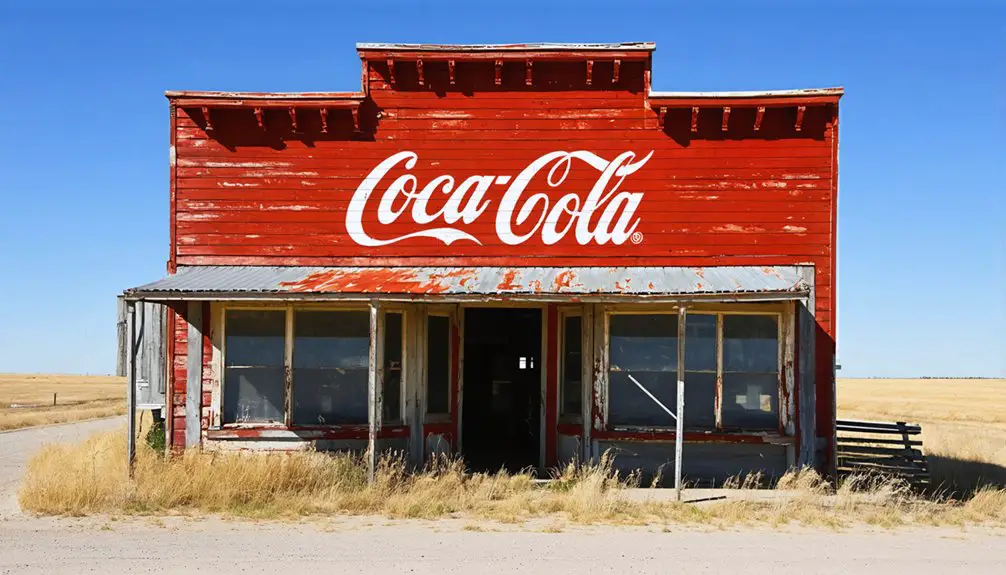
During Lincoln Valley’s peak years between the 1940s and 1960s, you’d have found residents gathering at the local general store to purchase farming supplies and exchange news of the day.
You could’ve joined the town’s German-Russian families at their church services, where traditional hymns and customs maintained strong cultural ties to their European roots.
As seasons changed, you would’ve witnessed the community coming together for harvests, school events, and celebratory festivals that marked the rhythms of rural North Dakota life. Today, these community memories are preserved in digital archives where digital asset management helps protect and share Lincoln Valley’s rich heritage.
Daily Community Activities
Life in Lincoln Valley’s golden years revolved around a vibrant mix of essential activities that bound the community together.
You’d find yourself immersed in a rich tapestry of social gatherings, from lively community picnics to spirited barn dances that echoed with German-Russian folk music.
The daily rhythm of life centered around these key activities:
- Trading and bartering at the general store, where neighbors exchanged goods and caught up on local news.
- Seasonal hunting and fishing expeditions that provided both recreation and food.
- Women’s gatherings at sewing circles and quilting groups, sharing stories while creating practical items.
- Evening storytelling sessions during long winter months, preserving cultural heritage and strengthening community bonds.
Church and Social Gatherings
At the heart of Lincoln Valley’s social fabric, churches served as essential community anchors throughout the mid-20th century, with Peace Evangelical Lutheran, St. Andrew’s Lutheran, and the Lincoln Valley Baptist Church leading the way.
You’d find these churches hosting more than just Sunday services – they were vibrant centers of cultural preservation, especially for the Germans from Russia population.
Church events marked life’s significant moments, from baptisms to funerals, while community gatherings in church halls strengthened social bonds.
Ladies Aid groups organized charitable activities, and you could even catch occasional movie showings in multi-purpose spaces.
The Baptist Church’s 75th anniversary celebration in 1975 exemplified these community traditions.
Through detailed church records and the preservation work of local historians like Alice Essig, Lincoln Valley’s religious institutions maintained both spiritual life and cultural heritage for generations.
Local Business Operations
The bustling commercial landscape of Lincoln Valley emerged around 1900 when George and Conrad C. Reiswig established the town with German/Russian settlers.
You’d find important businesses that formed the backbone of local economic resilience, including:
- General merchandise stores offering everything from groceries to hardware
- Blacksmith shops maintaining critical farm equipment
- Grain elevators facilitating agricultural trade
- Post office serving as a significant communication hub until the 1970s
Local business sustainability faced significant challenges when the planned Great Northern Railroad extension never materialized.
Without rail access, shipping costs increased, and economic growth remained limited. While nearby towns with rail connections thrived, Lincoln Valley’s businesses relied solely on serving immediate community needs.
The post-war period saw declining patronage, leading to gradual closures of important services and eventual abandonment.
The Post Office Era
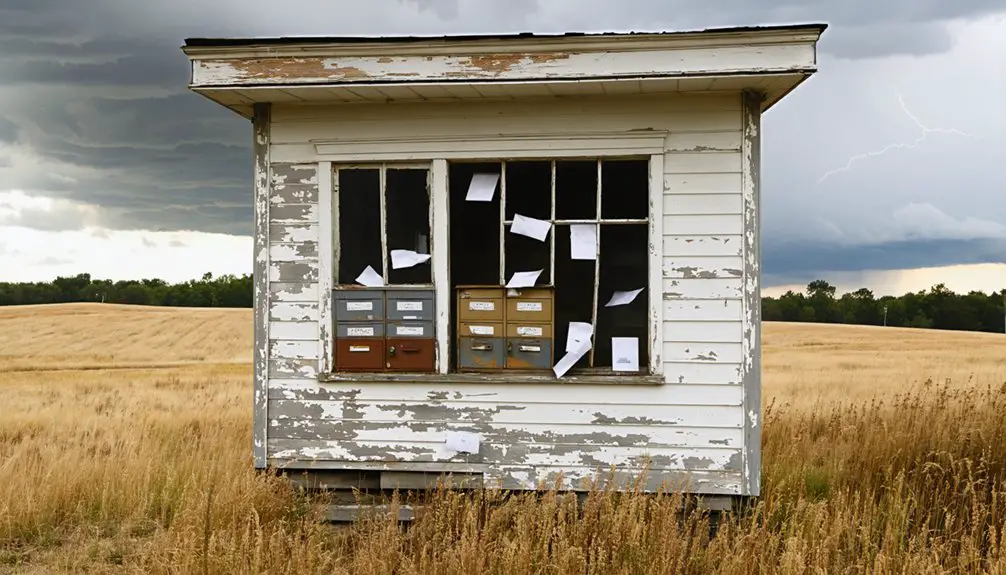
While small rural communities often struggled to establish permanent services, Lincoln Valley secured its official post office in 1904, marking a significant milestone in the town’s development.
You’d have found this postal hub serving as the town’s primary communication center, connecting residents to the wider world through mail delivery and news distribution.
The post office’s presence elevated Lincoln Valley’s status, encouraging settlement stability and modest growth during the early 1900s.
You would’ve seen it operating as more than just a mail station – it was an essential gathering place that strengthened community bonds.
After serving the area for over five decades, the post office closed its doors in 1961, signaling Lincoln Valley’s transformation into a ghost town.
The closure marked the end of an era that had kept the town connected and vibrant.
Signs of Community Decline
Signs of Lincoln Valley’s decline emerged gradually throughout the mid-20th century, as economic challenges and population loss transformed this once-vibrant agricultural community.
Lincoln Valley’s slow fade from prosperity mirrored countless rural towns, as economic hardship gradually emptied its streets of life.
You’ll recognize these clear economic indicators and population changes that marked the town’s descent into abandonment:
- The younger generation’s exodus for education and employment left primarily elderly residents behind.
- Local businesses, including general stores and blacksmith shops, shuttered their doors permanently.
- The post office’s closure in the early 1970s dealt a significant blow to community services.
- The school’s shutdown eliminated a crucial social hub for remaining families.
Without railroad access and facing increasing isolation, Lincoln Valley’s remaining residents found themselves dependent on distant towns for basic necessities, while abandoned buildings and deteriorating infrastructure became stark reminders of the community’s fading liveliness.
Abandonment and Ghost Town Status
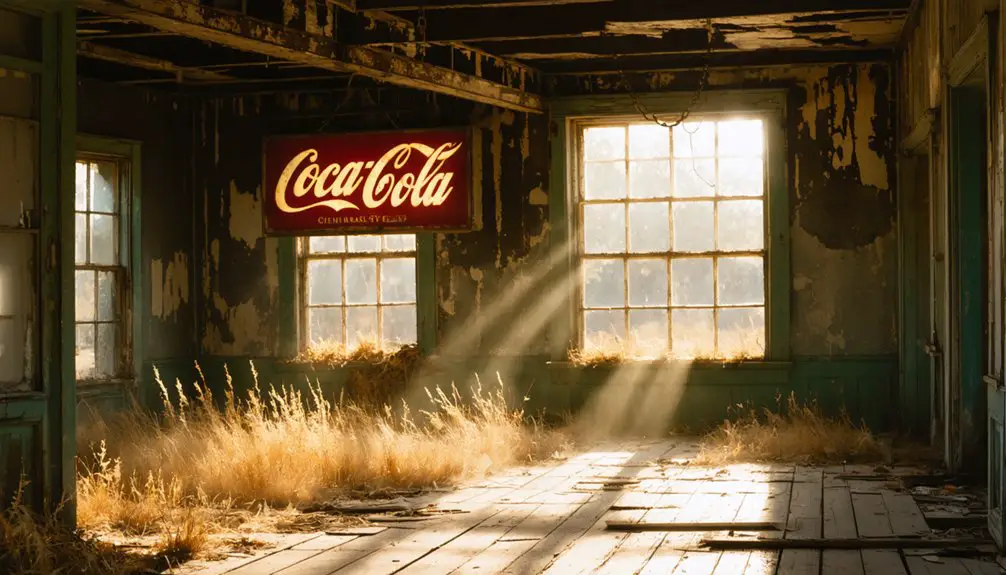
Lincoln Valley’s transformation into a ghost town unfolded through a series of defining events, beginning with its hopeful establishment in 1900 by Conrad and Abraham Reiswig.
You’ll find the town’s decline directly tied to transportation failures, particularly when the Great Northern Railroad‘s promised extension from New Rockford never materialized.
While the community managed to thrive through the 1950s and 1960s, the economic decline accelerated sharply after the post office’s closure in the early 1970s.
Without essential services and proper transportation links, you’d see residents gradually relocating to better-connected towns.
The agricultural community, once bustling with German/Russian immigrants, couldn’t sustain itself as regional economic shifts and infrastructure limitations took their toll, leading to its current ghost town status in Sheridan County.
Historical Preservation Efforts
Through coordinated efforts between tribal nations and state agencies, extensive preservation initiatives for Lincoln Valley began in earnest during the 1950s.
Walter and Alice Ripplinger Essig pioneered heritage preservation by documenting German-Russian history, while tribal collaborations guaranteed thorough archaeological surveys.
Key preservation accomplishments include:
The preservation initiatives yielded major accomplishments, marking milestones in protecting cultural heritage and historical sites across the region.
- Formation of the North Dakota Historical Society of Germans from Russia
- Multi-million dollar state investments in historic sites and interpretive centers
- Creation of the State Historic Sites Registry for legal protection
- Implementation of annual educational events connecting youth with their heritage
You’ll find that community involvement remains crucial, with volunteers and cultural specialists working together to protect Lincoln Valley’s legacy through ongoing fundraising, digitization efforts, and cultural programming that honors both Native American and settler histories.
Visiting Lincoln Valley Today
While visiting the former townsite of Lincoln Valley today requires careful preparation, you’ll find the ghost town located 8 miles northeast of McClusky in Sheridan County, North Dakota.
For successful ghost town exploration, you’ll need detailed maps or GPS, as there’s no signage or maintained infrastructure to guide you.
The site now consists primarily of open fields, with few visible remnants of the original town. You’ll need to navigate rural roads through farmland, being mindful of private property boundaries.
Since there aren’t any facilities, bring necessary supplies and inform others of your plans. During your visit, you might spot faint traces of old foundations or road patterns, though most structures have vanished completely.
McClusky serves as your closest source for basic amenities and services.
Frequently Asked Questions
Are There Any Remaining Original Buildings Still Standing in Lincoln Valley Today?
You’ll find several original structures still standing, including a deteriorating church and an identifiable former bar/ice cream parlor, though historical preservation efforts are minimal and most buildings have vanished since the 1970s.
What Happened to the Families Who Left Lincoln Valley?
You’ll find these family legacies scattered across North Dakota’s cities and neighboring states. Most relocated to urban areas for jobs, while farming families moved to fertile nearby lands or joined other German/Russian communities.
Did Any Notable Events or Crimes Occur in Lincoln Valley?
You won’t find any notable incidents or crime records from Lincoln Valley’s history. The town’s story focuses on its German-Russian settlers, farming life, and gradual decline through the 1970s.
Were There Any Schools or Churches Operating in Lincoln Valley?
You’d think such basic facts would be crystal clear, but records show churches definitely operated during Lincoln Valley’s heyday, while the school history remains tantalizingly murky in surviving documents.
What Natural Disasters or Severe Weather Impacted Lincoln Valley’s History?
You’ll find severe flood events impacted the area in 1997, with waters reaching two miles inland. Drought effects periodically stressed local agriculture, while tornados and winter storms created additional hardships.
References
- https://us1033.com/a-haunting-look-at-some-real-life-north-dakota-ghost-towns/
- https://www.ghosttowns.com/states/nd/lincolnvalley.html
- https://ghostsofnorthdakota892857007.wordpress.com/2017/01/25/lincoln-valley-revisited/
- https://ghostsofnorthdakota892857007.wordpress.com/2017/05/09/lincoln-valley-nd/
- https://digitalhorizonsonline.org/digital/collection/ndsl-books/id/41821/
- https://www.ndstudies.gov/gr4/early-settlement-north-dakota/part-1-early-settlement-north-dakota/section-9-railroads
- https://www.ndstudies.gov/gr8/content/unit-iii-waves-development-1861-1920/lesson-1-changing-landscapes/topic-6-railroads/section-2-northern-pacific-railway-north-dakota
- https://en.wikipedia.org/wiki/Northern_Pacific_Railway
- https://www.american-rails.com/nd.html
- https://www.history.nd.gov/publications/are-we-germans-russians-americans.pdf

